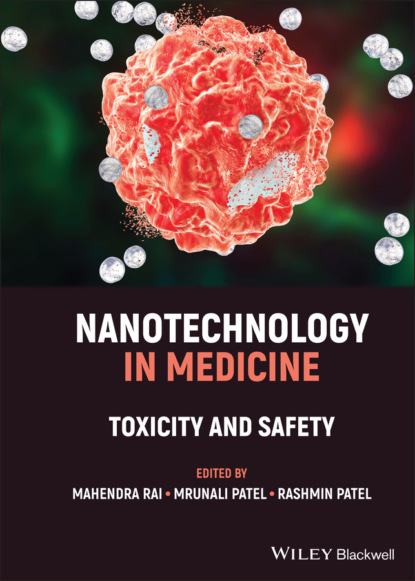Quality Attributes and Regulatory Concerns of Nanomaterials 17.3 Quality Assessment of Nanomedicines 17.4 Current Regulatory Framework over Nanomaterials 17.5 Conclusion and Future Outlook References
11 Index
List of Tables
1 Chapter 1Table 1.1 An overview of the classification of nanomaterials based on vario...Table 1.2 Diverse nanotoxicological concerns of nanomaterials.
2 Chapter 2Table 2.1 Microbial biopolymers of industrial relevance.Table 2.2 Antitumoral nanoparticles (NPs), nanofibers and nanofilms/antimic...
3 Chapter 4Table 4.1 List of selected most important protozoan diseases in humans.Table 4.2 Examples of protozoan diseases in animals.
4 Chapter 5Table 5.1 Increase in cellular levels ofO2−, NADPH, and MDA for diffe...Table 5.2 Factors affecting the toxicity of metallic nanoparticles.
5 Chapter 6Table 6.1 Safety evaluation tests for mesoporous silica nanoparticles (MSNs...
6 Chapter 7Table 7.1 Summary ofin vivo evaluations of nanoparticle toxicity based on o...Table 7.2 Review of toxicity study of polymeric nanoparticles.
7 Chapter 8Table 8.1 Antibacterial activity studies of chitosan–metal nanoparticle com...
8 Chapter 9Table 9.1 Clinically evaluated gene delivery nanocarriers and their toxicit...
9 Chapter 10Table 10.1 Tests for accessing toxicity of nanoparticles.
10 Chapter 11Table 11.1 Current marketed formulations with polymeric and lipidic nanopar...
11 Chapter 12Table 12.1 List of different nanomaterials and their respective drug nanoen...
12 Chapter 13Table 13.1 Applications of nanocarriers for drug delivery.Table 13.2 Applications of nanosponges in targeted delivery.
13 Chapter 14Table 14.1 Various applications of nanomaterials in a different segment.Table 14.2 Probable risks associated with nanoparticles in the human body.Table 14.3 In vitro, in vivo, and in silico approaches for the assessment of tox...Table 14.4 Objective/application of nanosafety assessment tools.
14 Chapter 15Table 15.1 The studies mentioning the risks of biomedical nano‐products pub...Table 15.2 Studies mentioning the regulation of biomedical nano‐products pu...Table 15.3 Overview of problems and consequences of the regulation (or lack...
15 Chapter 16Table 16.1 Widely accepted definitions of nanotechnology.Table 16.2 Applications of nanotechnology.
16 Chapter 17Table 17.1 Nanotechnology Products Database (NPD) indicating status of nano...Table 17.2 In vitro systems for nanotoxicology.Table 17.3 General rules and regulation applicable in various regions havin...Table 17.4 Various international standards given by NCL in the field of nan...Table 17.5 Various international standards given by ASTM in the field of na...Table 17.6 Some of the international standards and documents given by TNSC ...Table 17.7 Classification of nanomaterials as per Indian guideline.Table 17.8 Summary of WHO recommendations to protect workers from the poten...Table 17.9 Various testing methods and report on safety of manufactured nan...Table 17.10 Various international standards and guidance given by ISO in th...Table 17.11 Various technical reports and specifications given by ISO in th...Table 17.12 Timeline of various initiatives, strategies, milestones, resear...
List of Illustrations
1 Chapter 1Figure 1.1 Nanoscale properties and allied benefits of nanomaterials in nano...Figure 1.2 Nanomaterial applications in tissue engineering and regenerative ...Figure 1.3 Consequences of environmental contact of nanoparticles.
2 Chapter 2Figure 2.1 Scheme of the productive chain of fossil‐based polymers.Figure 2.2 Biopolymers and building blocks obtained by fermentation.Figure 2.3 Chemical structure of (a) poly(ε‐caprolactone) (PCL), (b) poly(la...Figure 2.4 Main pathways of the metabolism of benzene and its derivatives in...Figure 2.5 Aerobic biodegradation pathways of aromatic compounds conducted b...
3 Chapter 3Figure 3.1 Methods for the synthesis of selenium nanoparticles.Figure 3.2 Toxic effects of selenium nanoparticles.
4 Chapter 4Figure 4.1 Scheme of AgNPs’ biosynthesis and stabilization using linden leav...Figure 4.2 Drug delivery systems based on nanomaterials which were tested to...Figure 4.3 (a, b) TEM micrographs of AgNPs biosynthesized from 10 and 5 ml o...Figure 4.4 SEM images of Tetrahymena sp. trophozoites, after 60 minutes of e...Figure 4.5 Morphology of P. marinus hypnospores before and after interaction...
5 Chapter 5Figure 5.1 Copper nanoparticles induced cellular apoptosis via mitochondrial...Figure 5.2 Important physicochemical factors affecting AuNP toxicity. Decrea...
6 Chapter 6Figure 6.1 Bioapplicability of mesoporous silica nanoparticles (MSNs).Figure 6.2 Safety evaluation parameters of mesoporous silica nanoparticles (...
7 Chapter 7Figure 7.1 Dialysis method.Figure 7.2 Solvent evaporation method.Figure 7.3 Nanoprecipitation method.Figure 7.4 Application of polymeric nanoparticles.Figure 7.5 Safety concern of polymeric nanoparticles.
8 Chapter 8Figure 8.1 A schematic illustration of iodinated CS‐Cu NP composite synthesi...Figure 8.2 A schematic illustration of the proposed mechanism of antibacteri...
9 Chapter 9Figure 9.1 (a and b) represent different configurations of solid‐core lipid ...Figure 9.2 Toxicity mechanisms of components of gene delivery nanocarriers. ...Figure 9.3 Structures of cationic lipids and ionizable cationic lipids evalu...Figure 9.4 Structures of a few cationic polymers evaluated/being evaluated i...
10 Chapter 10Figure 10.1 Types of lipid nanoparticles.Figure 10.2 Toxicity due to nanoparticles.
11 Chapter 11Figure 11.1 Illustrations of carriers nanoparticulated and surface’s functio...
12 Chapter 12Figure 12.1 Illustration of different layers of the skin and various routes ...Figure 12.2 Schematics of different types of nanoformulations used in topica...
13 Chapter 13Figure 13.1 Nanostructured drug delivery systems.Figure 13.2 Nanonutraceuticals – considerations for
